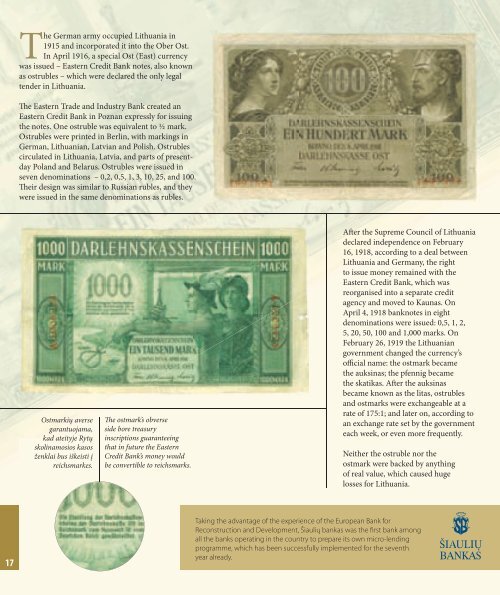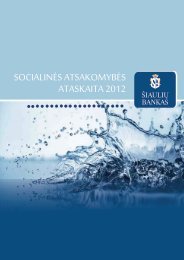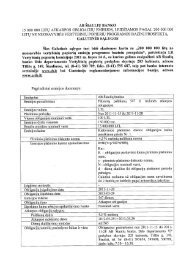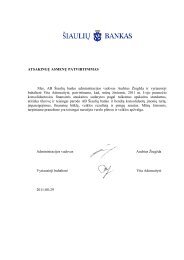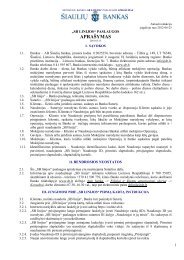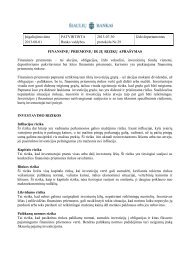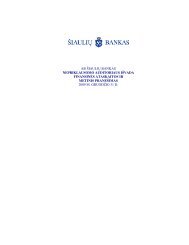Po 1871 m., kai susikūrė Vokietijos imperija, markė ... - Šiaulių bankas
Po 1871 m., kai susikūrė Vokietijos imperija, markė ... - Šiaulių bankas
Po 1871 m., kai susikūrė Vokietijos imperija, markė ... - Šiaulių bankas
You also want an ePaper? Increase the reach of your titles
YUMPU automatically turns print PDFs into web optimized ePapers that Google loves.
17<br />
The German army occupied Lithuania in<br />
1915 and incorporated it into the Ober Ost.<br />
In April 1916, a special Ost (East) currency<br />
was issued – Eastern Credit Bank notes, also known<br />
as ostrubles – which were declared the only legal<br />
tender in Lithuania.<br />
� e Eastern Trade and Industry Bank created an<br />
Eastern Credit Bank in <strong>Po</strong>znan expressly for issuing<br />
the notes. One ostruble was equivalent to ½ mark.<br />
Ostrubles were printed in Berlin, with markings in<br />
German, Lithuanian, Latvian and <strong>Po</strong>lish. Ostrubles<br />
circulated in Lithuania, Latvia, and parts of presentday<br />
<strong>Po</strong>land and Belarus. Ostrubles were issued in<br />
seven denominations – 0,2, 0,5, 1, 3, 10, 25, and 100.<br />
� eir design was similar to Russian rubles, and they<br />
were issued in the same denominations as rubles.<br />
Ostmarkių averse<br />
garantuojama,<br />
kad ateityje Rytų<br />
skolinamosios kasos<br />
ženklai bus iškeisti į<br />
reichsmarkes.<br />
� e ostmark’s obverse<br />
side bore treasury<br />
inscriptions guaranteeing<br />
that in future the Eastern<br />
Credit Bank’s money would<br />
be convertible to reichsmarks.<br />
A� er the Supreme Council of Lithuania<br />
declared independence on February<br />
16, 1918, according to a deal between<br />
Lithuania and Germany, the right<br />
to issue money remained with the<br />
Eastern Credit Bank, which was<br />
reorganised into a separate credit<br />
agency and moved to Kaunas. On<br />
April 4, 1918 banknotes in eight<br />
denominations were issued: 0,5, 1, 2,<br />
5, 20, 50, 100 and 1,000 marks. On<br />
February 26, 1919 the Lithuanian<br />
government changed the currency’s<br />
o� cial name: the ostmark became<br />
the auksinas; the pfennig became<br />
the skatikas. A� er the auksinas<br />
became known as the litas, ostrubles<br />
and ostmarks were exchangeable at a<br />
rate of 175:1; and later on, according to<br />
an exchange rate set by the government<br />
each week, or even more frequently.<br />
Neither the ostruble nor the<br />
ostmark were backed by anything<br />
of real value, which caused huge<br />
losses for Lithuania.<br />
Taking the advantage of the experience of the European Bank for<br />
Reconstruction and Development, <strong>Šiaulių</strong> <strong>bankas</strong> was the fi rst bank among<br />
all the banks operating in the country to prepare its own micro-lending<br />
programme, which has been successfully implemented for the seventh<br />
year already.


